Imagine if you could see what your customers are thinking. That’s basically what behavioral segmentation lets you do. It helps you understand your customers better, so you can speak to them in a way that truly connects.
Want to know more about behavioral segmentation?
Behavioral segmentation means grouping your customers based on what they actually do — like what products they buy, what content they look at, or how often they visit your app or website.
Marketers are a bit like a mix of businesspeople and psychologists — we try to figure out how people will respond to our campaigns. But with behavioral segmentation, we don’t have to guess anymore. Instead of making assumptions, we look at what users actually do and use that to send messages that really match their needs.
Once you know how different users behave, you can create campaigns that really speak to them — and that’s powerful.

And why should you care about behavioral segmentation?
When you understand how people think and act, it’s way easier to connect with them. Here’s why it matters:
- Personalization that works
You’ll know what they like, where to reach them, and what kind of messages get them interested. More clicks, more chats, more sales. - Smarter spending
By seeing which audiences bring the most value, you can put your time and money where it counts most. - Better planning
Notice patterns in what your customers do, and you’ll be ready for what’s next before it happens. - Stronger loyalty
When people feel understood, they stick around. That means repeat visits — and more spending over time.
Learn from this easy examples of behavioral segmentation
Behavioral segmentation is all about understanding how your customers act. When do they use your product? How often? For how long? This kind of insight helps you create better marketing messages and deliver a smoother user experience.
Here are some simple and relatable examples to help you understand how behavioral segmentation works in the real world:
1. Buying and Usage Habits
Let’s say someone uses a ride-hailing app every weekday to get to work. But on weekends, they prefer to drive themselves and never open the app.
If the ride-hailing company understands this, they could send that user a weekend discount to encourage them to use the app even on days they usually don’t.
Tracking when and how people use your product can help you predict demand and improve your marketing.
2. Timing of Purchases
People shop differently depending on the occasion. Think about:
- Big life moments (like buying an engagement ring)
- Seasonal needs (like gifts during the holidays)
- Everyday habits (like buying coffee every morning)
Starbucks, for example, knows many of their customers visit in the morning. So, they sometimes send offers for a second coffee later in the day to bring those customers back.
3. Benefits People Are Looking For
Customers don’t all use your product the same way or for the same reason.
Let’s go back to Starbucks:
- Some customers love the convenience of ordering ahead through the app.
- Others enjoy chatting with the barista and soaking in the coffee shop vibe.
- Some like to order online but sit and work in the café for hours.
When you know what each group cares about, it’s easier to give them exactly what they want.
4. Loyalty
Loyal customers are gold. And they deserve a little something extra.
Many companies use loyalty programs to say “thank you” to their best users. For example, Starbucks has a points-based system where frequent buyers can earn free drinks faster than before.
Simple loyalty rewards (like “buy 9, get the 10th free”) can go a long way in keeping people coming back.
Other behaviors to keep an eye on:
- How satisfied your users are
- How engaged they are with your product
- Whether they’re first-timers or long-time user

Want to know some simple tips for using behavioral segmentation?
Personalization really works. No matter how people act, everyone appreciates a little personal touch. Even something as simple as seeing your name in a message can grab your attention. But it doesn’t stop there. When you get how your users behave, you can build marketing that feels smarter, more relevant — and way more effective.
Here are some simple ways to apply behavioral segmentation in your mobile marketing:
1. Bring Users Back with Retargeting
What people did before usually hints at what they’ll do next. That’s why past behavior is super helpful for predicting future moves. If someone watched a certain kind of video on YouTube, there’s a good chance they’ll want to see more like it. That’s basically how YouTube’s recommendations work. Even the ads people clicked on before can help shape what they see next.
So if you know what your users enjoy, you can send them content and products they’re way more likely to click on again.
2. Use Location to Your Advantage
Where your users are—or were—can tell you a lot. For example, you can send notifications when they’re near your store using a technique called geofencing.
Apps like Uber and Grab look at user behavior by neighborhood to predict demand and adjust pricing. If it’s Saturday night near a busy bar area, they know more drivers are needed—and prices might go up.
They also use your location and past habits to guess where you’re going. Open the app on Monday at 8 a.m. from home? It might suggest your office automatically.
3. Adjust Prices Based on Device
Not all customers are the same—and their devices give clues. For instance, Apple users tend to spend more, while Android users might be more budget-conscious. Some businesses use this data to show different prices depending on the device.
It may sound sneaky, but it’s really about matching offers to customer expectations and purchasing power.
4. Recommend Products That Make Sense
Ever noticed how Amazon always seems to know what you might want to buy next? That’s behavioral segmentation in action. It looks at what you’ve bought and what similar customers have done, then makes suggestions.
5. Send Messages at the Right Time
Timing is everything. Some users check your app in the morning, others at midnight. If you know when they’re most active, you can time your push notifications and emails to get better results.
Let’s say you have lots of users in South America who use your app late at night. Instead of sending messages in the early morning (when they’re asleep), try sending them just before midnight to get more attention.
News apps do this a lot too—deciding when to send breaking news vs when to send personalized stories based on user behavior.
6. Learn from the Past
Yes, past behavior again! It can tell you what someone might want to do next. Google Drive’s “Quick Access” shows you files you’re likely to open based on your habits—not just recent ones, but ones you often check around the same time.
Google also uses this idea in Gmail, suggesting the next word while you type, based on your writing history.
You don’t need to be as big as Google or Amazon to use these techniques. Even small businesses can take advantage of behavioral insights to improve their user experience and marketing results.

And now, start simple with behavioral segmentation
Here are some easy ways to begin:
- Run remarketing campaigns based on what users did before.
- Send targeted content depending on user interests, spending habits, or how often they use your app.
- Focus your marketing on users who are most likely to take action.
- Find high-value users by learning how they interact with your app.
- Time your messages to match when users are online and active.
- Customize content based on where users are, what language they speak, or what’s happening locally.
Behavioral segmentation isn’t just a nice-to-have—it’s a must for marketers who want to stay relevant and connect with users in a meaningful way. By understanding what users do, where they go, what devices they use, and when they’re most active, businesses can create smarter, more personalized campaigns that actually drive results.
At ProPS, we help you turn all that behavioral data into action. With our customer data platform and marketing automation tools, you can easily segment your users, launch tailored campaigns, and optimize the user journey across channels—boosting engagement, conversions, and long-term loyalty.
